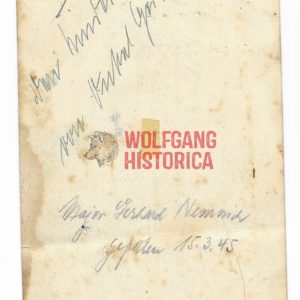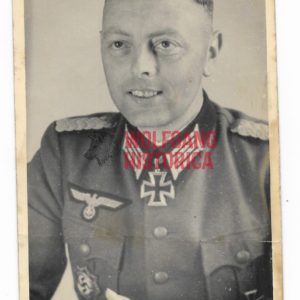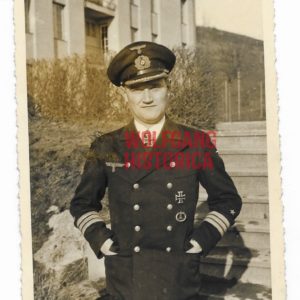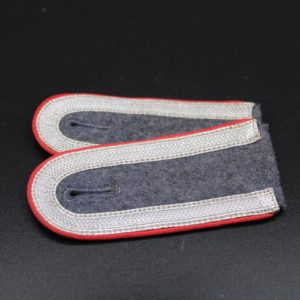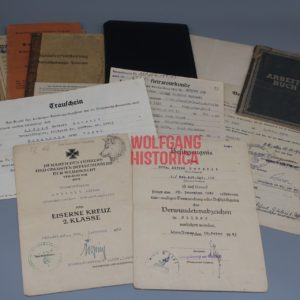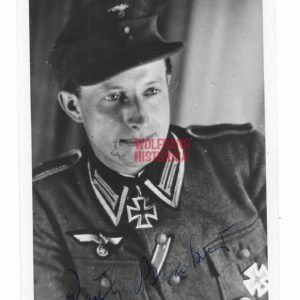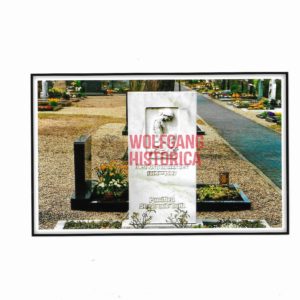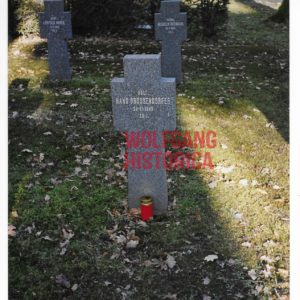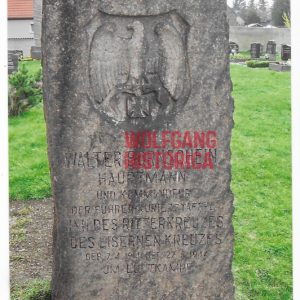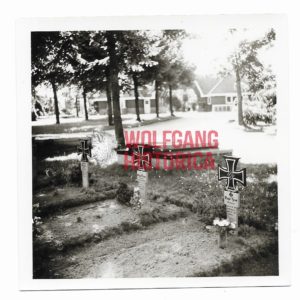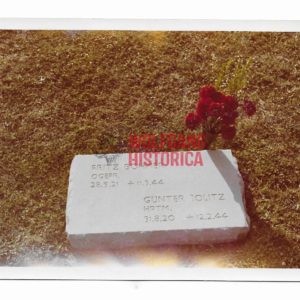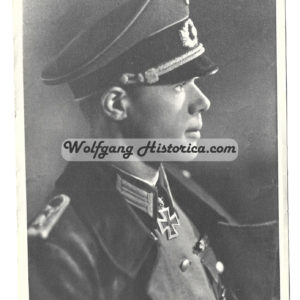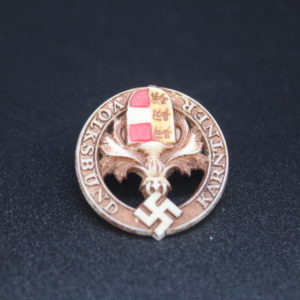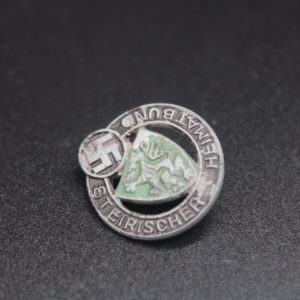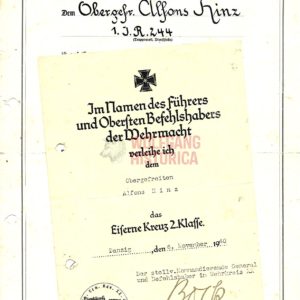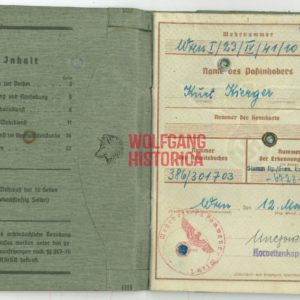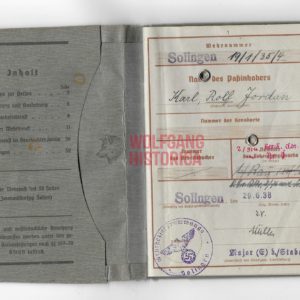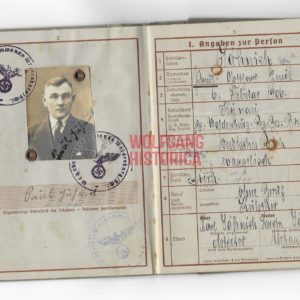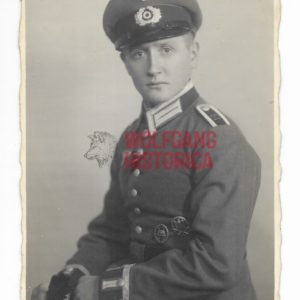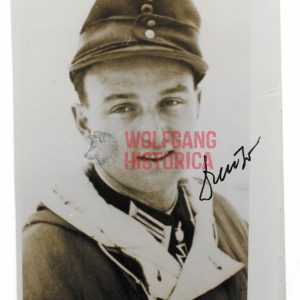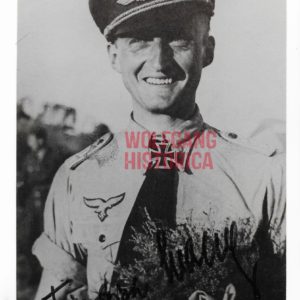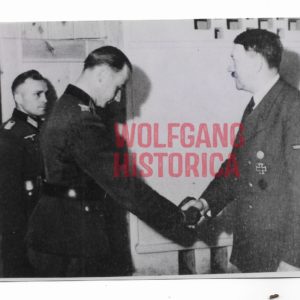Sign in
Login
Register
New Video on YouTube!
Ciney Militaria Show of April 2025
New militaria unboxing video today coming as well showing of the Ciney Pick-Ups
and newly arrived stuff which will soon be put up for sale!
“Gert” Nemnich – Panzer-Pionier-Bataillon 19 (Ritterkreuz) (Wartime Signed)
€105,00
Original Portrait with Wartime Signature of Gerhard "Gert" Nemnich. Major Gert Nemnich (10.11.1912 † 15.03.1945) earned the Deutsches Kreuz in Gold on February 28, 1942 and the Ritterkreuz onJuly 15, 1943 as Major und Kommandeur of the Panzer-Pionier-Bataillon 19 of the 19. Panzer-Division. Condition as seen. Postcardsize.
Ritterkreuz: "During the start of the battle of Kursk, along the front of the III. Panzer-Korps, Hauptmann Nemnich attacked across the Donez river with two of his Pionier-Kompanien. With these forces he eliminated 56 Soviet bunkers and their crews after heavy fighting. Following this action (which enabled his Division to cross the Donez here) he beat off a strong Soviet attack into the flank of the follow-up Kampfgruppen and even managed to push this defeated force back. For these actions he would be decorated with the Knight’s Cross."
Read more
Add to Compare
Horst Beeger – Lehrgeschwader 1 (Ritterkreuz)
€100,00
Original Photograph with Postwar Signature of Horst Beeger. Oberleutnant Horst Beeger (08.06.1913 † 03.03.1998) earned the Ritterkreuz on November 23, 1941 as Oberleutnant und Staffelkapitän of the 3. Staffel/ Lehrgeschwader 1. Good condition. Postcardsize.
Read more
Add to Compare
Viktor Schütze – Commander of U-103 (Eichenlaub)
€85,00
Original Portrait of Viktor Schütze. Käpitan zur See Viktor Schütze (16.02.1906 † 23.09.1950) earned the Ritterkreuz on December 11, 1940 as Korvettenkapitän und Kapitän of Uboot “U-103” and the Eichenlaub on July 14,1941 as Korvettenkapitän und Kapitän of Uboot “U-103”. Good condition. Postcardsize.
Read more
Add to Compare
Werner Hartmann – “U-37” & Fdu Mittelmeer (Eichenlaub)
€85,00
Original Portrait of Werner Hartmann. Käpitan zur See Werner Hartmann (11.12.1902 † 26.04.1963) earned the Ritterkreuz on May 9, 1940 as Korvettenkapitän und Kapitän of Uboot “U-37” and the Eichenlaub on November 5, 1944 as Kapitän zur See und FdU Mittelmeer . Good condition. Postcardsize.
Read more
Add to Compare
Luftwaffe Flak Unteroffizier (NCO) Shoulder Boards
€0,01
Original set of Luftwaffe Flak Unteroffizier (NCO) Shoulder Boards. Very good condition.
2x Award Docs: Iron Cross 2nd Class & WB Silver + Extra Docs (3.Geb.Div.)
€0,01
2x Award document set of Unteroffizier Albert Gutzeit, who earned all of his awards while serving with the Gebirgs-Artillerie-Regiment 112 of the 3. Gebirgs-Division! Comes with extra documents and papers related to his service and postwar life.
Read more
Add to Compare
- Eisernes Kreuz 2. Klasse (Iron Cross 2nd Class) for his (prior) service on January 5, 1942 which was signed by General der Gebirgstruppe Hans Kreysing (KC+EL+SW!). Zweitausfertigung.
- Verwundetenabzeichen in Silber (Wound Badge in Silver) for his wound sustained on December 29, 1942, which was signed by an unknown Doctor.
- Various extra ID's and documents...
Paul Becker – Artillerie-Regiment 3 (Ritterkreuz, Stalingrad)
€0,01
Original Postwar Signature on a Postwar Photocopy of Paul Becker. Unteroffizier Paul Becker (21.03.1918 † 29.11.1992) earned the Ritterkreuz on October 25, 1942 as Obergefreiter und Richtschütze in the 10. Batterie/ Artillerie-Regiment 3 of the 3. Infanterie-Division. Good Condition. Measuring: Postcardsize.
Knight’s Cross: “Obergefreiter Paul Becker had already destroyed 28 enemy tanks during the heavy combat near Kalatsch, and for this he was awarded the Iron Cross First Class. During the battle of Stalingrad he significantly contributed to the successful defense against enemy counterattacks through his personal bravery and decisiveness. The Bolsheviks commenced a furious attack with strong infantry forces that had the support of numerous tanks. Their aim was to break through the German blocking position to the north of the city. Obergefreiter Becker persevered throughout the fierce hostile fire while serving at his gun, and in the heavy fighting he destroyed 13 enemy tanks (most of which were heavy types). He smashed local enemy infantry penetrations with well laid fire. Thus, within a short time, Obergefreiter Becker destroyed a total of 41 Soviet tanks and decisively contributed to the great successes of his Division.”
Read more
Add to Compare
Postwar Photograph of Grave Leo Schuhmacher (Ritterkreuz)
€0,01
Postwar grave photograph of Leo Schuhmacher. Leutnant Leo Schuhmacher (13.11.1913 † 13.02.1997) earned the Ritterkreuz on March 1, 1945 as Leutnant und Flugzeugführer in the II. Gruppe/ Jagdgeschwader 1. Good condition.
Read more
Add to Compare
Postwar Photograph of Grave Hans Grossendorfer (Ritterkreuz)
€7,50
Postwar grave photograph of Hans Grossendorfer. Oberleutnant Hans Grossendorfer (11.08.1914 † 20.11.1943) earned the Ritterkreuz on March 26, 1944 as Oberleutnant und Beobachter in the 7. Staffel/Kampfgeschwader 53. Good condition.
Read more
Add to Compare
Postwar Photograph of Grave Walter Bornschein (Ritterkreuz)
€0,01
Postwar grave photograph of Walter Bornschein. Hauptmann Walter Bornschein (07.04.1914 † 27.04.1944) earned the Deutsches Kreuz in Gold on February 7, 1942 with II. Gruppe/ Kampfgeschwader 2 and the Ritterkreuz on September 24, 1942 as Oberleutnant und Flugzeugführer in the II. Gruppe/Kampfgeschwader 2. Good condition.
Read more
Add to Compare
Postwar Photograph of Grave Hugo Frey (Ritterkreuz)
€7,50
Postwar grave photograph of Hugo Frey. Hauptmann Hugo Frey (14.04.1915 † 06.03.1944) earned the Deutsches Kreuz in Gold on October 27, 1942 with 7. Staffel/ Jagdgeschwader 11 and the Ritterkreuz on May 4, 1944 as Hauptmann und Staffelkapitän of the 7. Staffel/ Jagdgeschwader 11. Good condition.
Read more
Add to Compare
Postwar Photograph of Grave Günter Jolitz (Ritterkreuz)
€7,50
Postwar grave photograph of Günter Jolitz. Hauptmann Günter Jolitz (31.08.1920 † 12.02.1944) earned the Deutsches Kreuz in Gold on October 27, 1942 with 3. Staffel/ Kampfgeschwader 55 and the Ritterkreuz on June 5, 1944 as Oberleutnant und Staffelführer of the 9. Staffel/ Lehrgeschwader 1. Good condition.
Read more
Add to Compare
Heinz Reintjes – Panzergrenadier-Bataillon 2102
€85,00
Original Wartime Studioportrait of Knight's Cross Holder Heinz Reintjes. Oberleutnant Heinz Reintjes (19.06.1915 † 15.11.1991) earned the Ritterkreuz on November 18, 1944 as Oberleutnant der Reserve und Führer of the Panzergrenadier-Bataillon 2102 of the Panzer-Brigade 101. Postcardsize.
Read more
Add to Compare
“Kärntner Volksbund” Membership Badge
€80,00
"Kärntner Volksbund" Membership Badge. Size: 23x24mm. Good condition.
Read more
Add to Compare
“Steirischer Heimatbund” Membership Badge
€0,01
"Steirischer Heimatbund" Membership Badge. Size: 21x24mm. Front in Worn Condition.
Read more
Add to Compare
2x Awards Docs: Iron Cross 2nd Class (1940) & Wound Badge Silver (Inf.Rgt.244)
€120,00
2x Award documents of Obergefreiter Alfons Hinz, who served with the Infanterie-Regiment 244 of the 60. Infanterie-Division.
Read more
Add to Compare
- Verwundetenabzeichen in Silber (Wound Badge in Silver), A4 size. Has been folded in the past. Signed by unknown officer.
- Eisernes Kreuz 2. Klasse (Iron Cross 2nd Class), A5 size. Earned for actions during the Western Campaign in 1940! Signed by General der Infanterie Max Bock (died in captivity).
Wehrpass – Grenadier-Regiment 565 & 432 (131.Inf.Div.) (Kowel, 3x Wounded)
€65,00
Original Wehrpass of Gefreiter Kurt Krieger, who served with 14. Kompanie/ Grenadier-Regiment 565 & 432 of the 131. Infanterie-Division. During his service he was wounded 3x times! Took part in the fighting for Kowel. Denazified within the Wehrpass (outside cover isn't).
Read more
Add to Compare
Wehrpass – Panzer-Artillerie-Regiment 76 & Sturmgeschütz-Abteilung 288 (3x Awards)
€275,00
Wehrpass of Unteroffizier Rolf Jordan who served with the Regimentsstab/ Artillerie-Regiment 76 & the 2. Batterie/ Sturmgeschütz-Abteilung 228. He was Killed in Action on September 3, 1943 near Borki by a "Panzerbüchse-geschütz Kopf" (hit by Panzerbüchse in the head) and earned the Verwundetenabzeichen in Schwarz (2x entered for 20.1.42 & 25.1.43 ?), Winterschlacht im Osten 1941/42 & the Eisernes Kreuz 2. Klasse. He got wounded on December 15, 1942 during the attempt to penetrate the Stalingrad pocket. He was trained as a 'Richtkanonier'. Good condition.
Read more
Add to Compare
Wehrpass Landesschützen-Btl. 637 (KIA 1943)
€70,00
Wehrpass of Gefreiter Paul Jahnich from the 3. Kompanie/ Landesschützen-Bataillon 637. He was Killed in Action on June 21, 1943. Good condition.
Read more
Add to Compare
Wehrpass Inf.-Rgt. 39 (1x Award, KIA) + Death Card
€100,00
Wehrpass of Schütze Hubert Breuer from the Infanterie-Regiment 39 of the 26. Infanterie-Division. During his service, he earned the Winterschlacht im Osten 1941/42. He was Killed in Action on August 13, 1942. Good condition.
Read more
Add to Compare
Wehrmacht Portrait – Died in Stalingrad (?) – Shoulderboards with Cypher “10”
€0,01
Studioportrait of Wehrmacht soldier, who may have perished in Stalingrad (?) (due writing on the reverse). He's also wearing shoulderboards with cypher "10". Postcardsize.
Read more
Add to Compare
Jozef-Georg Mulzer – Pionier-Bataillon 195 (95. Inf.-Div.)
€20,00
Postwar Signature on a Postwar Photo of Josef-Georg Mulzer. Major Josef-Georg Mulzer (15.04.1915 † 21.01.2011) earned the Ritterkreuz on September 7, 1943 as Major und Kommandeur of the Pionier-Bataillon 195 and the Eichenlaub on January 10, 1944 as Major und Kommandeur of the Pionier-Bataillon 195 of the 95. Infanterie-Division. Good condition. Postcardsize.
Knight’s Cross: “Major Mulzer fought with his Pionier-Bataillon in the sector of the 95. Infanterie-Division during the fighting for the Orel salient in mid-1943. In this time he and his men cleaned up numerous Soviet penetrations via energetic counterattacks and, on one occasion, he recaptured a commanding height in an attack launched on his own initiative. Mulzer would receive the Knight’s Cross for these actions.”
Oakleaves: “Near the end of 1943 the Pionier-Bataillon 195 occupied a defensive sector west of Bobruisk. Following an artillery barrage the Soviets attacked this sector with significant forces on a broad front. With his last reserves, namely soldiers from his staff as well as some drivers, Major Mulzer was able to eject the Soviet soldiers from his position and bring the attack in his sector to a halt. Meanwhile however the Soviets had managed to break through in the right neighbouring sector, and from here they threatened to roll up the whole Division’s frontline. Mulzer quickly recognized this danger and, assembling as many soldiers as could be spared, he launched a flank attack against this new opposing force. After a short but violent battle, the Soviets here fled after having suffered heavy losses. Major Mulzer then threw up a temporary defensive front and was able to hold it against all new hostile breakthrough attempts until the arrival of reinforcements. Through his bravery and decisiveness, Mulzer had thus averted a great danger for the whole German frontline west of Bobruisk. He would thus be awarded the Oakleaves to his Knight’s Cross.”
Read more
Add to Compare
Friedrich Lang – Sturzkampfgeschwader 2 & Schlachtgeschwader 1 (Swords)
€30,00
Postwar Signature on a Postwar Photo of Friedrich Lang. Major Friedrich Lang (12.01.1915 † 29.12.2003) earned the Ritterkreuz on November 23, 1941 as Oberleutnant und Flugzeugführer in the 1. Staffel/ Sturzkampfgeschwader 2 “Immelmann”, the Deutsches Kreuz in Gold on April 9, 1942, the Eichenlaub on November 21, 1942 as Hauptmann und Staffelkapitän of the 1. Staffel/ Sturzkampfgeschwader 2 “Immelmann” and the Schwertern on July 2, 1944 as Major und Kommandeur of the III. Gruppe/ Schlachtgeschwader 1. Good condition. Measuring: Postcardsize.
Werner Ziegler – Grenadier-Regiment 186 (Swords)
€0,01
Postwar Signature on a Postwar Photo of Werner Ziegler. Major Werner Ziegler (30.04.1916 † 15.04.2001) earned the Ritterkreuz on December 31, 1941 as Leutnant und Führer of the 2. Kompanie/ Infanterie-Regiment 186 of the 73. Panzer-Division, the Eichenlaub on September 8, 1942 as Oberleutnant und Führer of the 2. Kompanie/ Infanterie-Regiment 186 and the Schwertern on October 23, 1944 as Major und Führer of the Grenadier-Regiment 186. Good condition. Postcardsize.
Knight’s Cross: “On the 14.08.1941, during the battles between the Dniester and the Bug rivers, Leutnant Ziegler and his Kompanie took the heavily occupied town of Petrovskoye on the western bank of the Bug in a coup d’état and cleared out the surrounding area in bitter house fighting. More than 300 prisoners were captured in the process. Ziegler would be awarded the Knight’s Cross for this action.”
Swords: “Ziegler’s Regiment participated in the final battle for Sevastopol in May 1944. On the 07.05.1944, during the general Soviet attack against the German V. Armeekorps, his Regiment stood firm in its defensive positions on Windmill Hill, even after it had been surrounded. Ziegler and his men were able to hold their ground successfully until relieved by Kampfgruppen Marienfeld and Faulhaber on the morning of the next day. Ziegler would be awarded the Swords for this outstanding defensive stand.”
Read more
Add to Compare
Product Status
All Categories
- Campaign Shields
- Combat Awards
- Daggers
- Documents
- Erkennungsmarke
- Finnish Militaria
- Flemish Collaboration
- General Awards
- Iron Cross
- Japanese Militaria
- Medal Bars
- Other Nations
- Photos
- Porcelain & Cutlery
- Portraits
- Stickpins & Tinnies
- Storing & Archiving
- Uniforms
- Wartime Signed
- Wound Badges
- Archive (Sold)
- Awards & Decorations
- Uniforms & Insignia
- Papers & Documents
- Award Documents
- Death Cards
- Military & Civil ID's
- Postcards & Feldpost
- Literatur
- Photos & Postcards
- Signatures
- Kriegsmarine
- Luftwaffe & FJ
- Panzer
- Waffen-SS
- Wehrmacht
Brands
Sorry, we couldn't find what you're looking for
- Adolf Baumeister (Lüdenscheid)(1)
- Arbeitsgemeinschaft der Graveur-, Gold- und Silberschemiedeinnungen (Hanau)(1)
- Arbeitsgemeinschaft Metall und Kunststoff (Gablonz an der Neiße)(1)
- Arno Wallpach (Salzburg)(2)
- Berg & Nolte (Lüdenscheid)(1)
- C.E. Juncker (Berlin)(5)
- Carl Poellath (Schrobenhausen)(1)
- Carl Wild (München)(1)
- Deschler & Sohn (München)(1)
- Förster & Barth (Pforzheim)(1)
- Friedrich Linden (Lüdenscheid)(1)
- Friedrich Orth (Wien)(1)
- Fritz Zimmermann (Stuttgart)(1)
- Grossmann & Co (Wien)(1)
- Hauptmünzamt Wien (Wien)(2)
- Hermann Aurich (Dresden)(1)
- Julius Bauer & Söhne (Zella Mehlis)(1)
- Julius Maurer (Oberstein)(2)
- Karl Wurster K.G. (Markneukirchen)(1)
- Klein & Quenzer (Idar Oberstein)(2)
- L. Christian Lauer, Nürnberg (Nürnberg-Berlin)(1)
- Overhoff & Cie (Lüdenscheid)(1)
- Paul Meybauer (Berlin)(2)
- Rudolf A. Karneth & Söhne (Gablonz a.N.)(1)
- Rudolf Souval(1)
- Rudolf Wächtler & Lange (Mittweida)(4)
- Wächtler & Lange (Mittweida)(1)
- Walter & Henlein (Gablonz)(1)
- Wernstein (Jena)(3)
- Wilhelm Deumer (Lüdenscheid)(4)
- Wilhelm Hobacher (Wien)(1)

